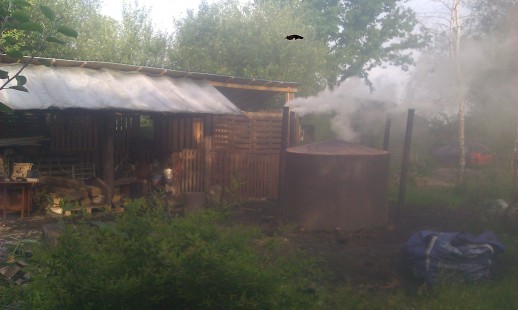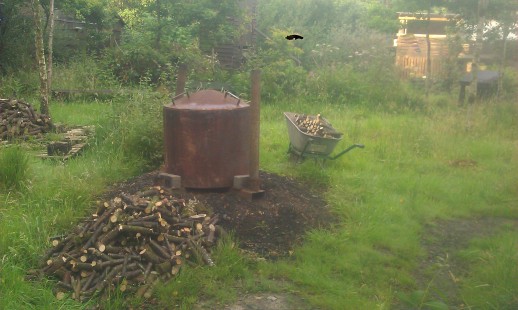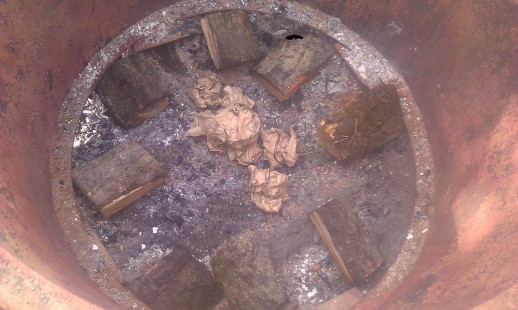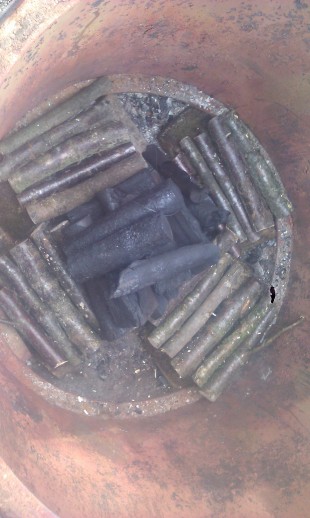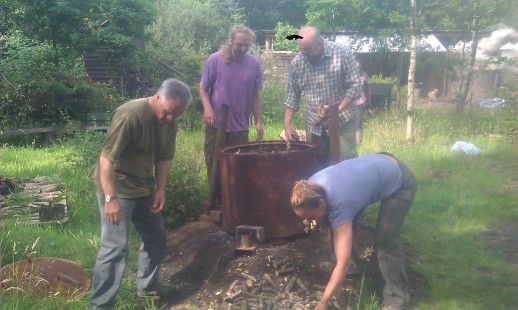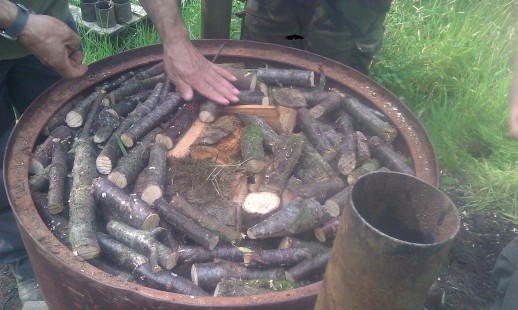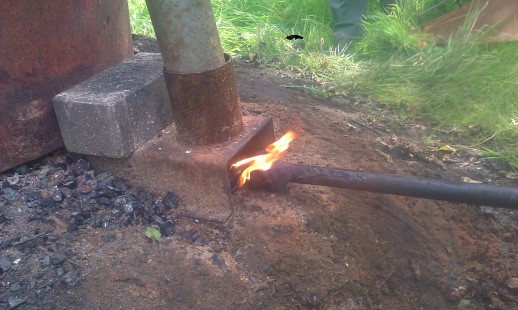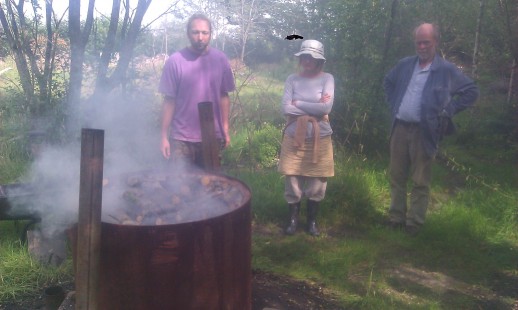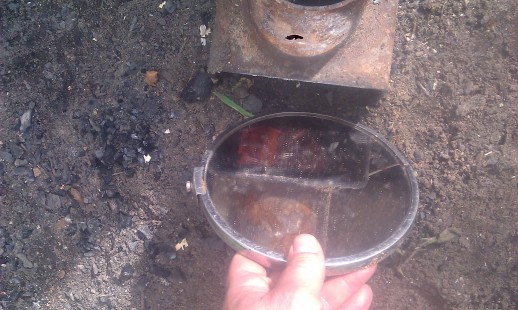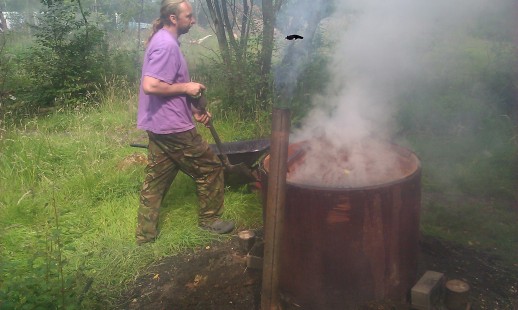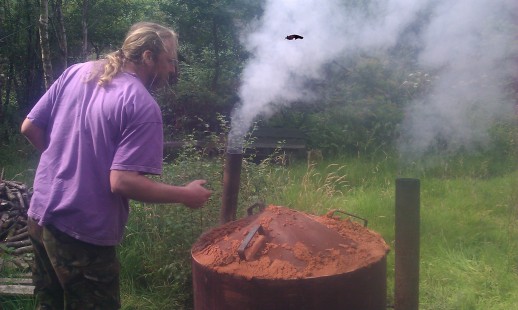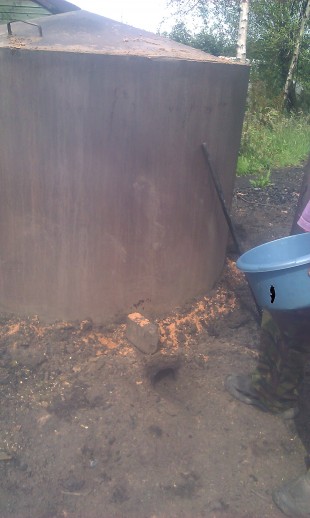Many thanks go to Pete and Anna of the Bulworthy Project in Devon for extending such a warm welcome to SWOG members by hosting a meeting at Henson’s wood . Pete and Anna have set up a charcoal making business and were kind enough to show us their method and explain the theory and nuances of the process.
(Apologies for the photos, that rather dark spot which looks like a map of Crete appears in them all, I think I might have got a bit of stray charcoal on the lens!)
It is a relatively new business, but they have already built a strong customer base and a reputation for producing the highest grade charcoal from both their own wood and a local woodland which they manage.
For their commercial burns, they have a large 6 foot diameter kiln which was loaded and ‘cooking’ when we arrived. It can take up to 24 hours to complete the process so for their courses and demonstrations, they have a much smaller kiln, which only takes about 5 hours.
This is the one we loaded. The first thing we did was put down some feet. These are just logs laid out on the bottom of the kiln leaving space around the vents in order to light it.
In the centre is the ‘Hovel’ this is the pile of tinder, to get the kiln going. On top of this, Pete put a pile of ‘brown ends’ (yes there’s a whole new vocabulary to learn!) These are just pieces of partly charred wood, super seasoned as they have already been though the kiln but didn’t completely turn into charcoal.
On top of the ‘feet’ go the ‘bridges’. These keep the rest of the wood from obstructing the inlets and outlets and allow access to the ‘hovel’ for lighting the kiln.
The rest of the wood can then be stacked on top.
Pete explained that he likes to get as much wood in the kiln as possible and that it is better to put the smaller pieces on the outside where it’s cooler and the larger logs in the middle where it’s hotter.
Once complete, the kiln is lit and the ‘freeburn’ begins.
This is done with the lid off and gives the fire a chance to get hold.
After 20 minutes or so, the fire is checked; a shaving mirror comes in handy for this! It beats bending down and grovelling on the floor to look into the vents!
If it’s all going well, the lid can be put on and sealed with damp sand.
Sand is also banked up around the bottom to prevent air coming in from anywhere apart from the vents.
This is the time to put the kettle on and light the barbeque!
Half way though, Pete and Anna, swap the inlets with the outlets, this just gives a more even burn around the whole diameter of the kiln.
Knowing when to shut the kiln down is also an art. The white ‘smoke’ is mainly steam and other impurities from the wood, once this is driven off, the smoke turns more translucent. This is the time to block all the vents, and let the kiln cool down.
Splashing water on the sides of the kiln is a way of checking that it has reached the temperature required to produce charcoal on the full height of the kiln.
The whole process does need careful monitoring, checking the inlets and outlets and that the fire hasn’t taken hold and turned your precious product into ash. This is of course easier with the smaller kiln as it only takes 5 hours or so, but the large kiln means a rather broken nights sleep.
It was great to see the process and have it explained so well by Pete and Anna. Once the kiln was shut down, they gave us a tour of the rest of the wood. Some of which has been set aside for the use of local school children who use is as part of their Forest Schools education. In another area, where their hens roost, a forest garden of fruit trees and herbs is starting to flourish.
The whole system is balanced and sustainable, Pete and Anna have built a lifestyle which is not only low impact, but also makes an important contribution to the local economy. It is heartening to see the emphasis they place on passing their skills and knowledge on through their courses and work with the local school children.
To book on a course or find out more about the project, visit their website
http://www.bulworthyproject.
Rich
________________
Richard Hare
SWOG website editor
